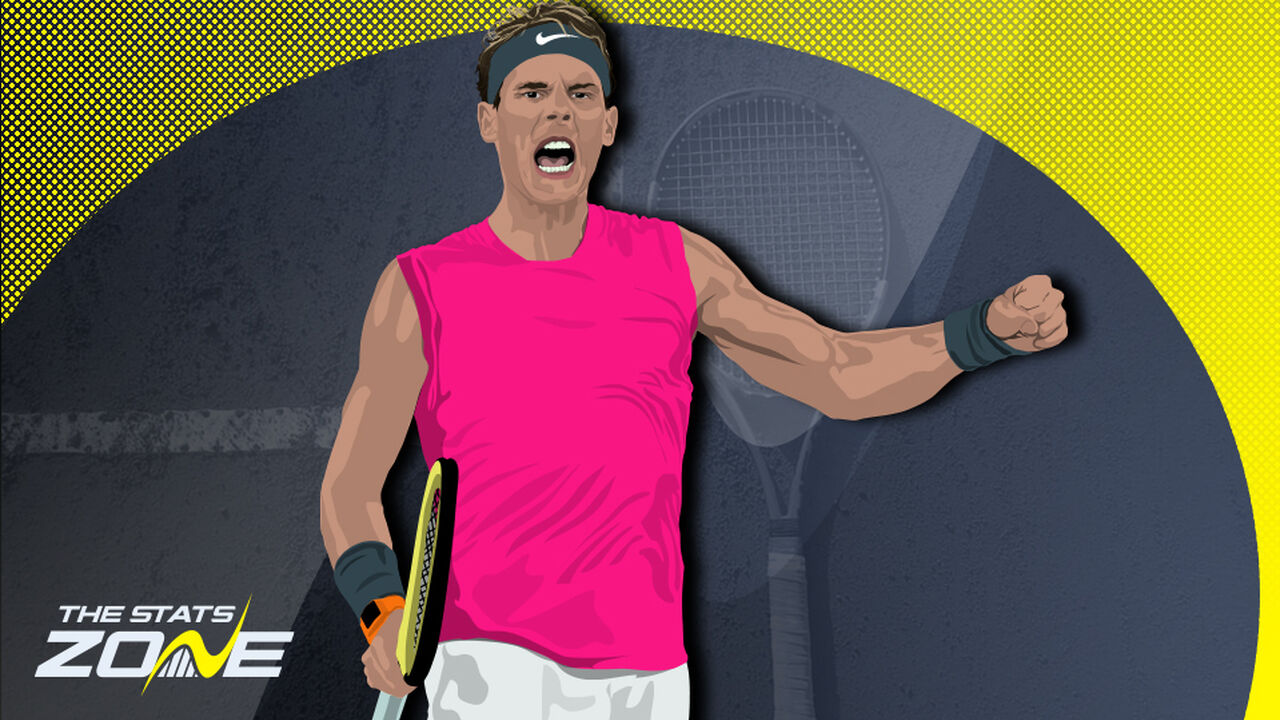The Key Numbers Behind Rafael Nadal's Incredible Career

Of all the glittering moments in Rafael Nadal’s legendary career there are few more affecting than at the Laver Cup in 2022, where the Spaniard sat next to old friend, and old foe, Roger Federer as the two wept at the close of an era-defining rivalry.
It was clear in Federer’s final Wimbledon campaign the previous summer, where his aura alone brought him as far as the quarter-finals, that his body could no longer support the weight of his masterful game at 41 years old. In truth, the Swiss probably held on to his career several years too long but, as the first of a trio that have defined tennis, now and forever, it seemed impossible that the sport could live on without him. That notion seemed to occur to the pair, especially Nadal, as they fought back tears; side by side as they had always been.
Them, on 10th October 2024, Rafael Nadal finally announced that he would be retiring later in the year, bringing to an end a career full of some truly inimitable achievements, and unbreakable records, in what was one of the most transformative legacies in all of sport. His final match, A Davis Cup quarter-final match against Botic van de Zandschulp on 19 November 2024, ended in defeat, but he will be remembered for so much more.
BEGINNINGS
Messrs Federer and Djokovic are never far from the conversation where Nadal is concerned but in an ever-convoluted ‘GOAT’ debate, that almost always comes down to personal preference, the Spaniard possesses perhaps the most singular achievements of the ‘Big Three’.
Nadal was, undeniably, the most impactful beginner of the three greatest players to ever hold a racket and one of the most successful teenagers in history. The Spaniard had already won 16 ATP titles, including his Roland-Garros debut in 2005, and reached world number two before his 20th birthday on tour, beating Federer from a set down to claim his second Coupe des Mousquetaires just a week after turning 20 in 2006.
In contrast, Federer claimed just one trophy in his teens and relative late-bloomer Novak Djokovic had barely broken inside the top 100. Carlos Alcaraz and Jannik Sinner, the two players likeliest to get even remotely close to the Big Three’s achievements since Andy Murray, had five and one title, respectively, before they turned 20.
By June 2006, Nadal could count six Masters crowns amidst his 16 teenage trophies and he never won more than the 11 titles claimed as a 19-year-old force of nature in 2005, coming close again eight years later in 2013 when picking up another 10 of his career total 92 titles.
HIGHLIGHTS
The fact that the Spaniard was still able to generate his formidable topspin at all at the latter end of his career was nothing short of astounding but, then again, Nadal’s career was forged in adversity. After upsetting Federer in their first ever encounter at the Miami Open in 2004, at just 18 years old, the bullish left-hander quickly became the arch-rival, but never arch-enemy, of the then peerless world number one.
Federer beat Nadal in five sets to lift the Miami title a year later, in a vengeful response that looked set to compel their future matches, but Nadal won each of their next five, including the 2006 Roland-Garros final, to begin what proved to be a reductive narrative: Nadal wins on clay, Federer wins on grass, and the pair are hard to separate elsewhere.
Nadal led their head-to-head record 8-6 coming into a fateful 2008 season, with the pair tied 2-2 in Grand Slam finals, all four won at their respective fortresses across the summer. The fact that Federer never bested Nadal at Roland-Garros is made all the more impactful by what many would call the greatest match of all time between the pair at Wimbledon in 2008, where Nadal came out on top of a five-set marathon to smash the Swiss’ streak of five trophies without reply.
The near-darkness of the winning point, claimed at 9:15pm due to rain delays and a then Wimbledon final record length of four hours and forty-eight minutes, adds to the mystique of this remarkable day but it is often misremembered that Nadal was a reasonable favourite on form coming into SW19. The Spaniard went on to win all four of their matches in 2008 to extend a lead that will forever be totalled at 24-16. Nadal leads Federer 10-4 in Grand Slam meetings and 14-2 on his favoured clay overall, whilst the Swiss leads 3-1 on grass and 11-9 on overall hardcourts (5-1 indoors, with Nadal edging outdoors 8-6).
The Wimbledon final of 2008 was perhaps the first time that tennis fans realised that Federer had never held the lead in their storied head-to-head and it, arguably, signalled the end of the great’s time in the sun – if not his place at the head of the records.
It feels significant, then, that Nadal was the first of the Big Three to surpass Federer’s Men’s Singles Grand Slam record of 20 at the Australian Open in 2022, increasing that lead once more before Novak Djokovic fulfilled his destiny in overcoming them both.
It was at the Australian Open that January, Novak Djokovic’s fortress, at the near-opposite end of Nadal’s career from his halcyon early days, that he shocked the world by usurping that seemingly unbreakable record.
Nadal had ended his season early the previous summer, citing yet another issue with his recurring foot injury, Achilles-esque in its threats to hamper his career, but the Spaniard returned to tour at the start of 2022 with cautious optimism before promptly stunning the field at a warm-up event in Melbourne.
That he then managed to take that form into a Grand Slam campaign and suffer few hiccups, barring a slight dip in five sets against Denis Shapovalov in the quarter-finals, en-route to the final was miraculous enough. But to come back from two sets down to best then US Open champion Daniil Medvedev 7-5 in the fifth, with the Rod Laver Arena in rapturous disbelief, to break that record was perhaps the greatest achievement of his life.
Nadal has suffered far more injuries, at far more inopportune times, than his Big Three peers and he embodies that ‘does-not-know-he’s-beaten’ cliché more than anyone. The Spaniard’s on-court routines and superstitions can look superfluous to some but it is undeniable that he plays every point like his last, resetting after every high, every low, and simply dismissing pain in favour of victory.
The Spaniard's 14th and final Roland-Garros title came later that summer, having beaten world number one Novak Djokovic in an epic quarter-final, conceding just six games to runner-up Casper Ruud whilst his left foot was totally medically numbed – as it had been for the entire campaign – to allow him to play at all.
CLAY DOMINANCE
The numbers behind Rafael Nadal’s dominance of Roland-Garros, and of his favoured clay during his near 20-year stay at the top of the sport, are truly unbelievable.
Nadal is the most successful player on clay in history. He holds an imperious 63-8 record in overall clay-court finals and he has won each of his 14 finals on Philippe-Chatrier without even once playing a deciding fifth set. He has lost just four times at Roland-Garros to set an unassailable win percentage of 97%. The Spaniard also holds title records at Monte-Carlo (11), Rome (10), Madrid (5) and Barcelona (12) and set the longest single-surface streak in the Open Era in 2007, winning 81 matches on clay in a row. He had never lost two matches on clay in a row until 2024, when it was clear that his days were numbered.
Despite his recurring injuries, Nadal has arguably been the most consistent of the Big Three over the past two decades. He holds the record for winning at least one Grand Slam title every year between 2005 and 2014 and he has done so in more years (15) than anyone else in history. Inevitably, as it had with Federer and will with Djokovic, time came for the great champion. Nadal dropped out of the top 10 of the ATP rankings in March 2023, doing so for the first time in a truly astonishing 18 years.
As aforementioned, whilst Novak Djokovic has gone on to set a new Men’s record of 24 Grand Slam titles and, undeniably in this metric, completed the ‘GOAT’ debate, it is notable that Nadal leads 5-4 in their major finals – two of which came away from clay in New York (2010 and 2013).
The pair have met 60 times, more than any other match-up in Open Era history, with Djokovic remarkably edging it 31-29 overall. Nadal leads 20-9 on clay, Djokovic 20-7 on hardcourts, and they are tied 2-2 on grass. Their remarkable Australian Open epic in 2012 was the longest final in Grand Slam history, falling just shy of six hours before Djokovic came out on top.
IN SUMMARY
Elsewhere, Nadal spent a total of 209 weeks at world number one, sixth behind Djokovic, Federer, Pete Sampras, Ivan Lendl and Jimmy Connors but he is the only player to hold that top spot in three different decades (2008-2020). He is one of only three men, alongside Andre Agassi and now Djokovic, to complete the career Golden Slam (winning all four majors and a Gold Medal over the course of a career) but the first to do so with a Gold in singles (Beijing 2008) and doubles (Rio 2016). Alongside his 92 career titles are four Davis Cups won as part of several generations of Spanish teams (2004, 2009, 2011 and 2019).
If Roger Federer played tennis like he’d invented the game, and Novak Djokovic plays like he was destined to set every record, then Rafael Nadal simply refused to lose. Perhaps this is why, more than his equals, only his body could call time on his career. His determination to win every point, at any cost, has worn his physicality to the core.
The Spaniard’s mastery of clay will be his most lasting legacy, his record at Roland-Garros surely secure for all time whilst Djokovic continues to erode Federer’s history in almost every capacity, but Nadal leads them both across their combined 32 matches played at Grand Slam level; Federer 10-4 and Djokovic 11-7. When it mattered most, Nadal, more than anyone else, found a way.



